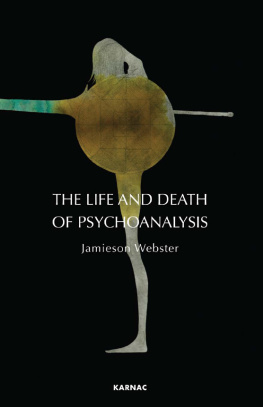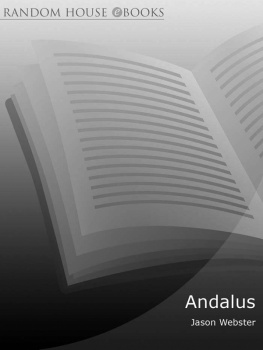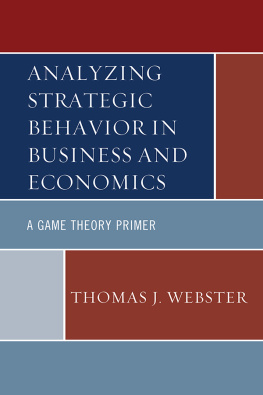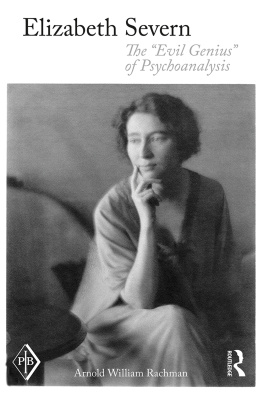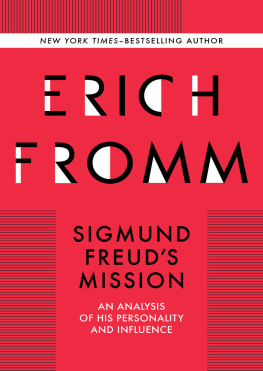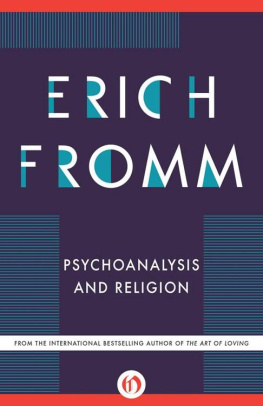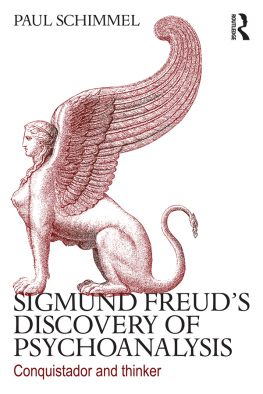First published in 2011 by
Karnac Books Ltd
118 Finchley Road
London NW3 5HT
Copyright 2011 by Jamieson Webster
The right of Jamieson Webster to be identified as the author of this work has been asserted in accordance with 77 and 78 of the Copyright Design and Patents Act 1988.
All rights reserved. No part of this publication may be reproduced, stored in a retrieval system, or transmitted, in any form or by any means, electronic, mechanical, photocopying, recording, or otherwise, without the prior written permission of the publisher.
British Library Cataloguing in Publication Data
A C.I.P. for this book is available from the British Library
ISBN-13: 978-1-85575-899-5
Typeset by Vikatan Publishing Solutions (P) Ltd., Chennai, India
Printed in Great Britain
www.karnacbooks.com
For Simon and Soren
ACKNOWLEDGEMENTS
Id like to thank my colleagues, Lisabeth During, Patricia Gherovici, Ben Kafka, Danny Kaiser, Todd Kesselman, Renata Salecl, and Marc Strauss, for a generous and lasting intellectual friendship. Danny Kaiser deserves credit for introducing me to Adorno over a decade ago. If he hadnt also demonstrated the power of language in Shakespeare, Melville, and Joyce, I might have stayed an Adornian. As well, my gratitude to the inimitable Judith Butler.
Id like to thank my fellow psychoanalysts without whom I couldnt balance the work of writing about analysis in the midst of practicing it: Nuar Alsadir, Howard Bliwise, Inga Blom, Will Braun, Rachel Gorman, Tehela Nimroody, Vanessa Sinclair; and Helen Zimmer for watching over all of us. A special thanks to Michael Garfinkle, whose commitment as a psychoanalyst has been a continued point of light during the darkest moments of training.
To Norbert FreedmanI will always hear you saying hello kiddo your work on symbolization has provided a much needed bridge between American and French psychoanalysis. Id like to thank my senior colleagues at the New York Psychoanalytic Institute: Francis Baudry, John Crow, Leon Hoffman, Donald Marcuse, Wendy Olesker, and Herb Wyman.
The dedication of my original dissertation committee deserves recognition: Elliot Jurist, David Lichtenstein, Angelica Nuzzo, Jean-Michel Rabat, and Lissa Weinstein. Id like to thank Lissa for offering me freedom with the humility fitting the best of psychoanalysts and supervisors, and Jean-Michel for his rigor, which has helped me think through the problems and merits of my work. Id like to express an almost inexpressible indebtedness to David Lichtenstein whose grace as a psychoanalyst has been intrinsic to finding anything of my own. That he knows this and I need not say it is one part of what makes this debt so invaluable, like the rare gift of silence from a psychoanalyst.
Last but mostmy love and gratitude to my family for enduring with me through this book, especially my son Soren whose patience with me I have been in awe of since the day he was born. To my husband, Simon Critchleyhow strange it is to think about the turn my life made all those years ago when you asked Alain Whats up with the math, dude? in homage to a little conversation between us. This book is inseparable from an encounter with you, with the deepest admiration for the courage of your work and unrelenting passion. I hope that it lives up to you, to what you have given to me. Thank you for making intellectual life such a seamless part of the psychopathology of our everyday life together.
ABOUT THE AUTHOR
Jamieson Webster, PhD, is a psychoanalyst in New York City. She teaches at Eugene Lang College and New York University. Her work focuses on clinical and theoretical psychoanalysis with an interdisciplinary focus on feminine sexuality, philosophy, and aesthetics. This is her first book.
PREFACE
It has been said that this book is something closer to a memoir than a work of scholarship. I dont quite understand the distinction, or rather, Im not sure what the pressure is on the side of the reader that makes that distinction an important means of orienting oneself in the face of the questionwhat is this that I have before me? I suppose, in a way, being somewhat without that particular anxiety, I allow myself to blur the line between what is personal and impersonal throughout this work, but it must be said that in doing so, I take Freud as my model.
As Jacques Derrida asked in To SpeculateOn Freud (1991), how can an autobiographical writing, in the abyss of an unterminated self-analysis, give to a world-wide institution its birth? (p. 531). Perhaps this question, this doubt even, could be transformed into a point of affirmation. It did. Isnt it marvelous? No other institution is born of this same abyss and no other institution must wrestle with it so much as psychoanalysis. Freud is the unmoved mover. Psychoanalysis is one of the strangest but perhaps most astonishing of institutions and practices.
So my anxiety in this work is less about the problems of self-r evelation, nor the constraints of autobiography, but rather the life and death of psychoanalysis itself. It is simply a fact that Freuds writing created a worldwide institution. It is perhaps also a fact that this psycho analytic institution is now in trouble. This historical juncture, over a century after its strange birth, is certainly my point of anxious orientation. While this work begins with the feeling that something of the nature of what is personal and passionate about psychoanalysis has been lostin particular from the position of a once analysand, now psychoanalystrather than expound upon the idea of what has gone missing, which I do not think would take us very far, this work attempts to tell a part of the story of how one becomes a psychoanalyst.
This story cannot be told without saying something about my relationship to psychoanalytic theory and philosophythat is my train-ingbut intends to use this dialog to show what in psychoanalysis changes the relationship between a subject and thinking, a change in the relationship we hold to knowledge on the whole. This also entails a shift in the love one maintains for precious interlocutors. In fact, I might wager that the former is only possible by virtue of the latter.
Divisions like the one proposed to exist between scholarship and memoir currently exist uncritically in psychoanalysis to a fault, in particular those drawn between theory and practice, or even between truth and falsity, as if memoir, for example, fell easily on one side or the other. I do not abide by this divide, and certainly not as one that is simply so, mapped with any ease. That being said, the incongruous hope of this piece of work is to force these two to work in tandem, and to do so through telling some part of the story of a psychoanalysts relation to theory in the process of trying to come to terms with what it means to practice psychoanalysis.
Lacan, for one, was often wary of certain false divisions, especially when they obscured a particular set of boundaries crucial to him and to psychoanalytic work; namely, the division between conscious and unconscious, between speaker and spoken of, between body and word, along with the enigma of the difference between the sexes. For Lacan, psychoanalysis uniquely forces a confrontation with these impossible, inevitable, divisions and barriers. He noticed that what a patient will come to say to an analyst that will have a critical effect on his or her life will be born as if from this gulf, this abyss.
Significant events seem to gather around these fault lines and highlight them, beyond all conscious intentionality, questioning most claims of ownership. The notion, dare I say hubris, that any given person would be able to sufficiently map a fault of this kind a priori is impossible. Such is the strange impossibility of psychoanalytic work. It is to these divisions and their unique personal elaboration that I am more wed than any contemporary means of orienting a readership.

